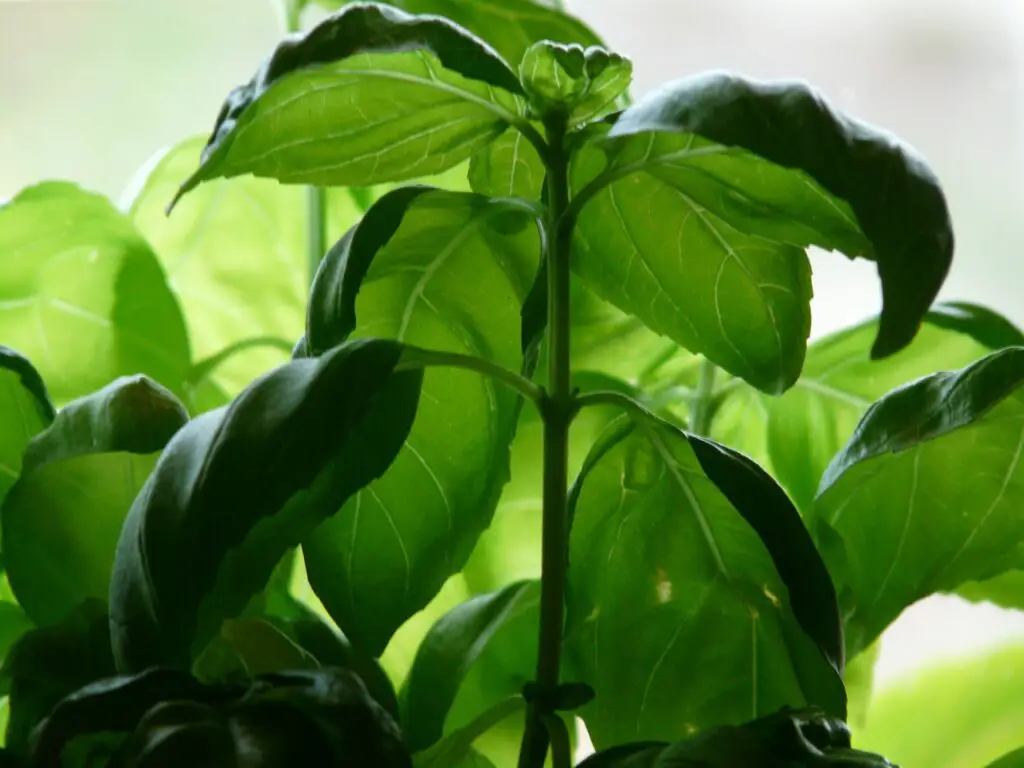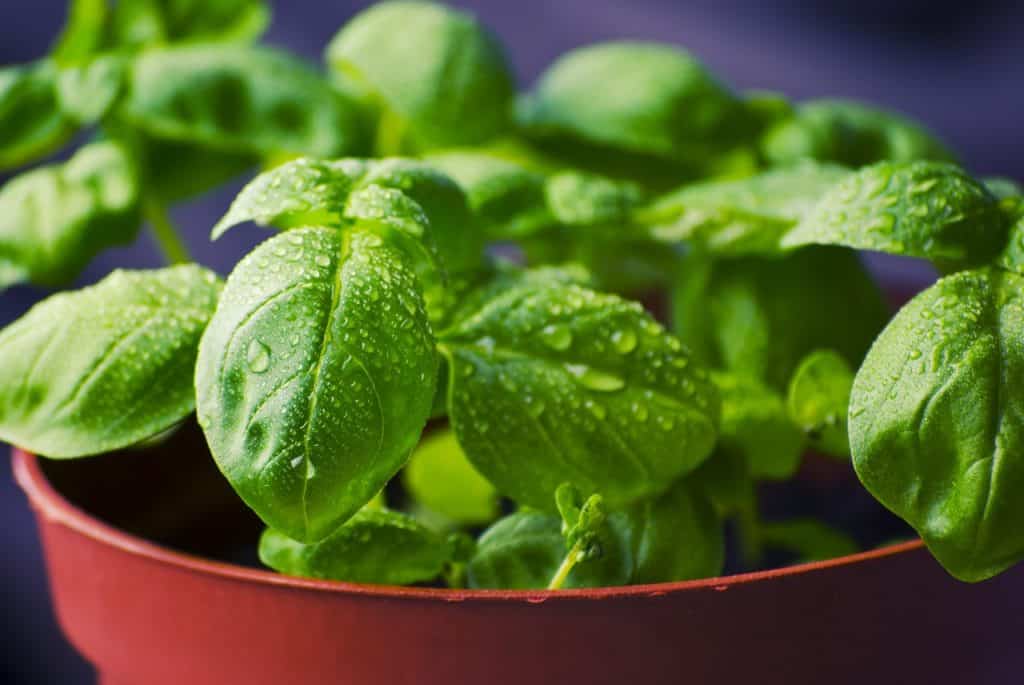
Watering basil correctly is key to its lush growth. Basil prefers consistent moisture, but it’s crucial to avoid overwatering. Allow the top inch of soil to dry out before watering again. Basil is generally speaking a pretty hardy plant in the right conditions, and one of those conditions being properly watered. Luckily we have put together this article to help you guide through it a lot easier. Use lukewarm water early in the day, ensuring you water the soil directly, not the leaves, to prevent fungal diseases. Overly wet conditions can lead to root rot, so well-draining soil and pots with drainage holes are essential. During hot spells, basil may need more frequent watering to stay hydrated and healthy.
How Often To Water Basil
How Regularly To Water Basil Based On Its Size
The watering needs of basil vary with its size. Mature plants require approximately 1 inch of water per square foot weekly, ensuring deep soil hydration. In contrast, basil seedlings, more prone to waterlogging, need about half this amount to thrive. It’s crucial to maintain moist, not soggy, soil conditions. For sprouting basil, a gentle approach with a plant mister helps keep the soil’s top layer appropriately moist, supporting healthy growth without overwhelming the young roots. Adjusting watering practices based on plant size is key to basil’s vitality.
How Often To Water Basil In Container Or Pots
Basil in containers demands more frequent watering compared to those planted in gardens, primarily due to several key factors. The limited soil volume in smaller pots leads to quicker drying, necessitating regular checks and water replenishment. The protective canopy formed by basil leaves often shields the soil from direct rainfall, reducing natural water absorption. Additionally, the material of the pot influences moisture retention; for instance, terracotta pots, being porous, allow more water to evaporate, accelerating soil drying. These considerations highlight the importance of a tailored watering schedule for potted basil, ensuring the soil remains evenly moist without becoming waterlogged, to support healthy plant growth.
How Basil Plants Hold Water
Basil thrives in humid conditions and has the unique ability to absorb moisture not just through its roots but also through its leaves, making misting a beneficial practice. While it primarily draws water from the soil via its root system, over-saturation can lead to root rot. To ensure adequate hydration without waterlogging, water until the soil begins to pool, then pause. After a few minutes, check the soil’s moisture 2 inches down. Repeat watering as necessary until this depth is uniformly moist, ensuring the plant receives sufficient water without compromising root health.
Does Basil Need Full Sun
Basil thrives in full sun, requiring at least 6-8 hours of direct sunlight daily to grow vigorously and produce aromatic leaves. Adequate sunlight is essential for photosynthesis, ensuring the plant’s health and enhancing its flavor profile. While basil can tolerate partial shade, its growth may be less robust, and the leaves might lack their characteristic strong scent and taste. For the best results, position basil plants in a spot where they can enjoy plentiful sunlight throughout the day.
Does Basil Need Full Sun Or Shade
Basil prefers full sun, needing 6-8 hours of direct sunlight daily for optimal growth and flavor. While it can tolerate partial shade, especially in hotter climates where afternoon shade can prevent wilting, its growth might not be as vigorous. For the fullest, most flavorful leaves, ensure your basil receives ample sunlight, positioning it in a spot that meets its light requirements while protecting it from extreme afternoon heat if necessary.
Can Basil Grow In Shade
Basil can grow in shade, but its growth and flavor may be compromised compared to plants receiving full sun. In shaded conditions, basil tends to produce fewer and less aromatic leaves. For best results, aim for light shade or partial sun, providing the plant with some direct sunlight each day. Adapting to less ideal light conditions, basil can still flourish but might require extra care and attention to ensure healthy growth and sufficient leaf production.

When To Water Basil
Signs That Basil Needs To Be Watered
When basil needs watering, it shows clear signs: leaves may appear wilted, limp, or less vibrant, indicating dehydration. The soil will feel dry to the touch, especially the top inch. Additionally, the plant might exhibit stunted growth or drooping stems. These symptoms signal an urgent need for water to revive the basil, ensuring it returns to its healthy, lush state with prompt and adequate hydration.
The Best Time Of The Day To Water Basil
The best time to water basil is in the morning. This timing allows water to penetrate deeply into the soil, reaching the roots before the heat of the day accelerates evaporation. Morning watering also ensures that any water that accidentally gets on the leaves can dry quickly, reducing the risk of fungal diseases. It sets the plant up for a day of photosynthesis and growth, optimizing health and productivity.
Signs Your Basil Is Underwatered
Underwatered basil exhibits clear distress signals that require immediate attention. Key indicators include:
- Wilting Leaves: Leaves appear limp and lifeless, indicating a lack of moisture.
- Drooping Stems: Stems lose their rigidity and begin to sag, signaling dehydration.
- Dry Soil: The top two inches of soil around the plant feel parched to the touch.
Mara advises checking the soil’s moisture level regularly. Basil demands a minimum of 1 inch of water weekly for optimal health and vigorous growth. Addressing these signs promptly can revive and maintain a thriving basil plant.
Signs Your Basil Is Overwatered
Mara points out that overwatering basil can lead to several problematic symptoms, indicating the need to adjust your watering practices. Be vigilant for signs such as:
- Brown or Black Spots on Leaves: These indicate water stress and potential fungal infections.
- Wilting Stems: Over-saturation leads to a lack of structural support.
- Yellow Leaves: Especially at the base, suggest nutrient uptake issues due to soggy soil.
- Foul Soil Odor: A telltale sign of root rot, resulting from excessive moisture.
Additionally, brown spots might also signal a too-cold environment for basil, similar to what happens when stored at low fridge temperatures. To prevent this, keep herbs in a crisper or towards the front of the fridge where it’s slightly warmer. This distinction helps in correctly diagnosing the issue and ensuring the health of your basil plant.
Basil Watering Schedule, Indoors And Outdoors
The watering schedule for basil, whether grown indoors or outdoors, is influenced by several factors including light exposure, ambient temperature, humidity levels, soil composition, and the type of potting container used. Basil prefers consistent moisture, but it’s crucial to avoid overwatering. Generally, outdoor basil might be watered once a week, but this frequency should be adjusted based on weather conditions and soil moisture. Indoor basil, on the other hand, often requires more frequent watering, potentially every 2-4 days, due to quicker evaporation rates in controlled environments. Potted basil, irrespective of being indoors or outdoors, tends to dry out more rapidly than basil planted directly in the ground, necessitating closer monitoring and more regular watering to maintain the ideal moisture level for healthy growth.
How Much To Water Basil Growing Inside
When watering indoor basil, aim to keep the soil consistently moist but not soggy. Typically, this means watering once every 3-5 days, depending on the pot size, indoor climate, and plant size. Check the soil moisture by feeling the top inch; if it’s dry, it’s time to water. Use lukewarm water to avoid shocking the plant’s roots, ensuring thorough soil saturation without leaving standing water in the saucer beneath the pot.
Light And Humidity
Basil thrives in bright, indirect sunlight, requiring 6-8 hours of light daily for optimal growth. It prefers a humid environment, mimicking its native tropical conditions. Indoor basil benefits from a humidity level around 40-60%. To increase humidity, consider placing a water tray near the plant or using a humidifier. Adequate light and humidity are crucial for healthy basil, promoting lush leaves and robust flavor.
Basil Potting Container
For basil, a well-draining container is key to prevent waterlogged roots. Choose a planter with drainage holes and opt for a sizeable pot, at least 9 inches deep and 12 inches wide, to accommodate root growth. Basil flourishes in raised beds or containers, as they provide excellent drainage and retain warmth, creating an ideal growing environment. This is especially beneficial during spring, aiding the plant’s establishment and promoting vigorous growth. Ensure your potting mix is nutrient-rich and well-aerated to support healthy basil development.

FAQ
Is It Better To Water Basil With A Hose Or Watering Can
For basil, using a watering can is generally better than a hose. It offers more control over the amount of water applied, ensuring a gentle, targeted watering that avoids disturbing the soil or damaging delicate leaves. The can’s spout allows for precise watering at the base, reducing moisture on foliage, which can lead to fungal diseases. This method promotes healthy root absorption and minimizes waste, catering to the plant’s specific needs.
Can You Overwater Basil
Overwatering basil can indeed be detrimental, leading to issues such as root rot and causing the leaves to wilt or turn yellow. It’s a common misconception that overwatering is solely about the volume of water applied at once. In reality, the frequency of watering is more often the culprit. Basil plants need time to absorb moisture and for the soil to dry out slightly between waterings.

